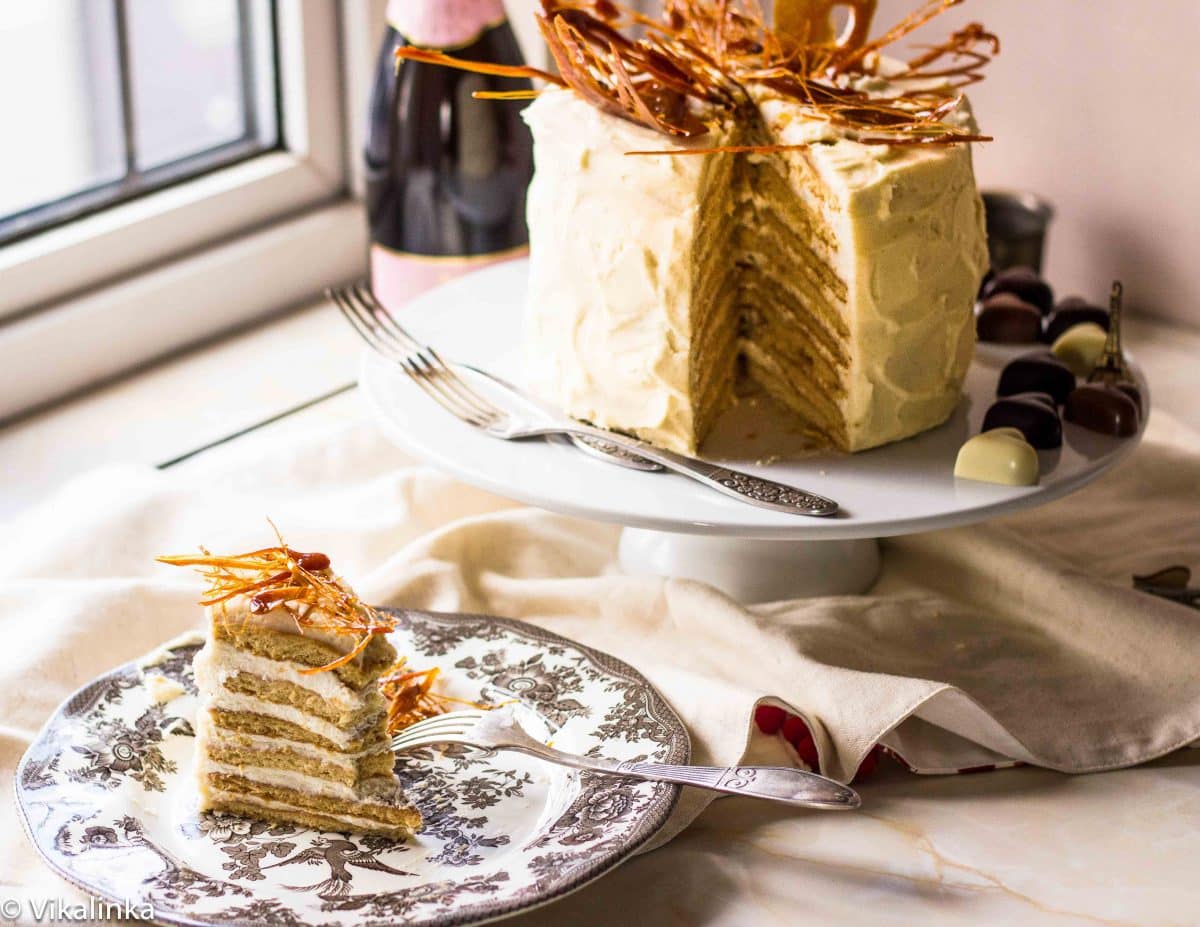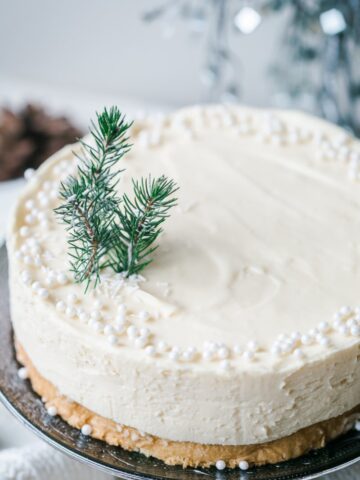This iconic Russian honey cake aka tort Medovik is something everyone needs to try at least once. Layers upon layers of honey goodness filled with the most delicious cream. It’s quite unforgettable.
Loving this cake recipe? For another classic Russian cake try my Apple Cake Sharlotka.
Honey Cake
The Russian name for this incredible cake is Medovik or Tort Medovik. And the first time I made it I was 13 or 14 when this cake was the “it cake” in Russia and all across the former Soviet Union.
The recipe was being passed on from one household to another although, of course there wasn’t one ‘master recipe”. Every cook made it her own. It was impossible to have any sort of celebration without Medovik crowning the meal.
It was so common that after a while it didn’t seem special anymore. I am glad I re-discovered this treasure because despite its simplicity of ingredients and the method of preparation the end result is far from plain.
What ingredients are in Medovik?
Honey in Russian is med, so you can expect honey to be one of the dominant ingredients in this cake. Although only 4 tablespoons is used, they add a very rich, caramel like flavour to the cake. This is due to a high quality, flavourful honey that’s been traditionally used in Russia.
My grandfather came for a beekeeping family and as a child I always remember seeing a large 3 litre jar of raw honey being stored in a kitchen cupboard. So using great tasting honey is the key to the unforgettable taste of this honey cake.
The rest of the ingredients are very common for cakes. Butter, sugar, flour, baking soda and vanilla make thin, cookie like layers of Medovik.
They are softened with a cream filling that is one part whipping cream and one part sour cream mixed with sugar and vanilla. Sometimes a filling made with butter and sweetened condensed milk is used. I however, find it too sweet.
How to make Tort Medovik
Although the ingredients for this Russian honey cake are quite common for a cake the method of preparation is quite unorthodox.
Cake Layers
Instead of making cake batter and baking it in cake pans this honey cake recipe calls for preparing cookie dough, then baking the layers one by one on cookie sheets.
Baking the thin layers is the lengthiest process according to this method but trust me it produces the most stellar results. This cake is so impressive that after it got discovered and reproduced by one San Francisco bakery it developed a cult following!
After the layers are baked they are cut into round circles or rectangles. You can see both versions in the photos.
When Medovik is made for large gatherings it’s not uncommon to make it into a large rectangular 4 layer cake instead of a tall 8 layer one. Both are authentic and equally delicious.
Caramel flames are not the traditional decor for Medovik but I wanted to add a little pizzazz to the special occasion cake as well as trying my hand at making caramel.
It turned out to be such a fun process, needless to say I was very pleased with the result but feel free to skip it. Traditionally Medovik cake is covered with the cake crumbs that are made from the offcuts from the layers.
Honey Cake Filling
Beat sour cream or creme fraiche with whipping cream, sugar and vanilla until sugar is dissolved and it’s doubled in volume. Fill all 8 cake except for the top and the sides.
Medovik Frosting
Once again I’ve changed the frosting as in the original Medovik. The filling above is used for the outside of the cake as well and later coated with the cake crumbs. Since I decided to go crumb free I’ve used a mascarpone frosting similar to the one I’ve used for my Naked Cake.
It needs to be noted that the cake is best served 24 hours after it’s made to allow the crispy layers to soften to a cake texture. A full day in a fridge is perfect for soaking the wonderful flavours from the filling and the frosting.
Caramel Flames (Optional)
Mix sugar with lemon juice in a saucepan, set the saucepan on medium heat. Do not stir until the edges start to bubble up, then start stirring until all the crystals melted, sugar looks clear and deep amber colour.
Take it off the heat and put the bottom of the pan in ice cold water to stop it from cooking immediately. Do not keep it there for too long or the caramel will harden before you have a chance to work with it.
Drizzle caramel with a spoon on parchment paper that was previously sprayed with an oil spray, let it set. Then break up the hardened caramel and decorate your cake in any way you like.
Caramel flames are best to be set on the top of the cake right before serving or the caramel start to get soft from being on contact with moisture.
You can have them made beforehand and pop them on top as you get ready to serve dessert.
This Medovik Cake Recipe was originally published in 02/2013. Updated with new text, photos and improved recipe instructions in 02/2020.
More popular cake recipes to try
- Honeycomb Crunch Chocolate Cake
- Victoria Sponge Cake
- Frostbitten Raspberry Cake
- Red Velvet Truffle Cake

Russian Honey Cake Medovik
Ingredients
For the cake
- 70g/5 tbsp unsalted butter
- 100g/1/2cup granulated sugar
- 4 tbsp honey I prefer dark honey for more flavour
- 3 eggs large
- 1 tsp vanilla
- 1 tsp baking soda
- ½ tsp salt
- 330g/3 cups all purpose flour
For the filling
- 500ml/2 cups creme fraiche or sour cream
- 500ml/2 cups double cream/whipping cream
- 50g/1/2 cup icing sugar/powdered sugar
- 1 vanilla bean or 1 tsp vanilla
For the frosting
- 250g/1 cup mascarpone chilled
- 125ml/1/2 cup double cream/whipping cream
- 100g/1 cup icing sugar
- 1 vanilla bean or 1 tsp vanilla
For the caramel flames
- 200g/1 cup sugar (half white and half brown sugar)
- ½ tsp lemon juice
Instructions
For the cake
- Preheat your oven to 400F/200C and line two baking trays with parchment paper. Set a double boiler or a large pot filled ⅔ with water and a glass or metal bowl over it on the medium heat. Melt butter, sugar and honey in the bowl. In a separate bowl beat eggs and vanilla and pour the mixture in the double boiler while mixing the whole time (I use electric mixer) to avoid ending up with scrambled egg.
- Then add baking soda, salt and 2 cups of flour, continue mixing for a few minutes until the dough starts to thicken and come away from the edges of the bowl. Take it off the heat and add the last cup of flour, mix well. Be careful as the dough will be hot.
- Allow it to cool for a couple of minutes and then knead it with your hands until your get smooth, pasta like dough. What you are looking for is a cookie dough rather than a cake batter. Divide into 8 equal parts and cover with a kitchen towel to avoid drying out. The cake layers will be baked separately on baking trays and then cut into neat circles using a 7″ cake pan, tart pan or, in my case, a pan lid as a template.
- Dust your work surface with flour and roll out a thin circle slightly larger than 7″, transfer on a parchment lined baking tray and bake for 4-5 min. Watch closely as the cake layers burn quickly. Roll out the next layer while the previous one is baking. That is why you need to have 2 baking trays on the go. Remove from the over when golden brown and cut out a circle while still hot as the layers will turn into crisp biscuits in a couple of minutes.
For the filling
- Beat creme fraiche or sour cream with whipping cream, sugar and vanilla until sugar is dissolved and it’s doubled in volume. Fill all 8 cake layers except for the top and the sides.
For the frosting
- Beat cold mascarpone with icing sugar, vanilla and whip cream until stiff. For the US users whip the whipping cream first with icing sugar then fold into slightly whipping mascarpone. Cover the sides and the top of the cake with mascarpone frosting.
For the caramel flames
- Mix sugar with lemon juice in a saucepan, set the saucepan on medium heat and don’t stir until the edges start to bubble up, then start stirring until all the crystals melted, sugar looks clear and deep amber colour. Take it off the heat and put the bottom of the pan in ice cold water to stop it from cooking immediately but don’t keep it there for too long or the caramel will harden before you have a chance to work with it.
- Drizzle caramel with a spoon on parchment paper that was previously sprayed with an oil spray, let it set. Then break up the hardened caramel and decorate your cake in any way you like
Notes
- It needs to be noted that the cake is best served 24 hours after it’s made. A full day in the fridge allows crisp layers to soften and soak all the wonderful flavours from the filling and the frosting.
- You can cut your layers into large rectangles and make your Medovik into a 4 layer cake.
Nutrition

















